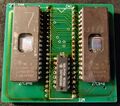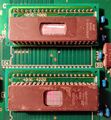Bootleg
From the carrying of bottles of smuggled spirit in the legs of boots.
en.wiktionary.org
A "bootleg" commonly refers to a counterfeit game cartridge, CD or system.
NeoGeo bootlegs are quite common, as SNK took years to implement security measures to avoid (or at least delay) piracy. Most are believed to originate from China and South Korea.
Over the years, multicarts gained popularity over single game bootlegs as memory chip costs decreased and decrypted ROMsets became available, making design easier and sales even more profitable.
Aside from the collection and authenticity aspect, bootlegs are known to be plagued with functional and electrical problems due to low quality manufacturing and/or poor design.
All pictures are crops from [MVS-Scans].
Recognizing bootleg cartridges
Efficiently recognizing bootlegs can be important for collectors, sellers and especially buyers. Some online sellers provide PCB pictures of their MVS games, but many of them only show the label or just an overall view of the cartridge (especially those for the home system, as they're more difficult to open).
Todo: how to open. MVS: easy, 4 screws. AES: snapped together.
Misleading clues
- EPROMs (memory chips with glass windows) were sometimes used by SNK for P ROMs.
- Flux residue around logic chips, might just be a repair job.
- A few late cartridges had their P ROMs replaced by a NGPC flash board. This is an original emergency solution/fix from SNK.
- Some other late cartridges had a small board (NEO-HYCS) wired to V ROMs and glued on top of them. This is also an original fix.
No gold plating
Original cartridge PCBs all have gold-plated fingers (slot contacts) for durability.
To reduce costs, some bootleg PCBs don't have gold plating (looks dark silver).
This can be checked without opening the cartridge.
Unusual chip brands
SNK had their favorite brands. If found on a cartridge PCB, these chip logos can be bad news:

From left to right, top to bottom:
- AMD: Memories, never seen on SNK boards
- Atmel: Memories and PLDs, often used in bootlegs
- Cypress: PLDs, often used in bootlegs
- Goldstar: Often found on bootlegs, sometimes on original boards
- Hyundai: Memories, never seen on SNK boards
- Macronix: Memories, never seen on SNK boards
- Microchip: Memories, never seen on SNK boards
- Motorola: Todo, remove
- Samsung: Never seen on SNK boards
- SST: Memories, never seen on SNK boards
- UMC: Rarely seen on SNK boards except for surface-mount memories
- Winbond: Memories, never seen on SNK boards
- Xilinx: Never seen on SNK boards, only Altera
Also Lattice (PLDs) and Intel (flash memories), never seen on SNK boards.
EPROMs or flash memory
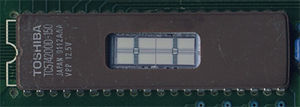
EPROMs, memory chips with erasing windows, are often used in bootlegs instead of plain plastic mask ROMs.
Note that some original cartridges use EPROMs as P ROM revisions.
Bad NGH marking
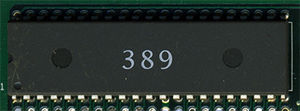
Memory chips only marked with a 3-digit number not matching the game's NGH number are certainly fake.
Sanded or rebranded chips
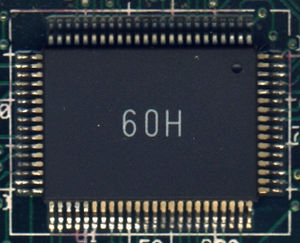
Some chips can be sanded (no markings, visible scratches...) to prevent other bootleggers from copying the design. Clone chips are often rebranded for the same reason.
SMT or DIP adapters
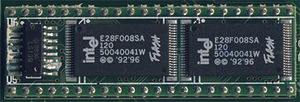
SMT and DIP adapters are small PCBs commonly found in bootlegs and converts. They allow the use of cheaper chips in place of EPROMs without having to change the whole board's layout or to use chips not compatible with the board, sometimes with the help of logic ICs.
They were often assembled by hand and therefore covered in flux barf (see below).
-
Two 8-bit Intel flash chips used in place of a 16-bit mask C-ROM.
-
Two 8-bit MX flash chips used in place of a 16-bit mask C-ROM.
-
One 8-bit Intel flash chips used in place of a 8-bit mask V-ROM.
-
Two 27c040 with logic.
-
Pinout adapter.
Uncommon board shapes
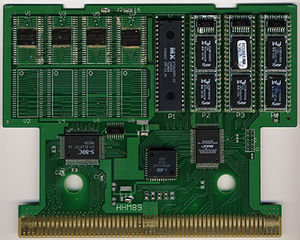
As some PCB manufacturers set their price depending on the board's area instead of the smallest containing rectangle, some bootleg PCBs were made in unusual shapes to reduce costs.
All known SNK cartridge PCBs are rectangular.
Soldermask not green
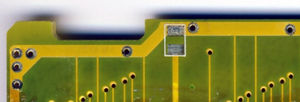
Many bootlegs use yellow soldermask (protection lacquer).
All known SNK boards use green.
Questionable markings
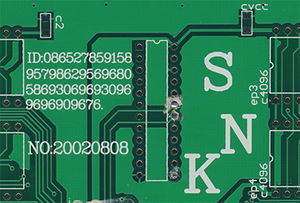
Meaningless "serial numbers", serif fonts, Engrish, bad alignment, bad logo proportions, and wrong line thickness are all signs of fake PCBs.
Sometimes, nothing is better than something (even if no silkscreen at all also means bootleg).
Paper labels
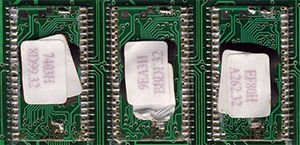
Paper labels are very rare in original cartridges, most manual QC markings were done with colored grease pencils.
Prototypes often used paper labels too.
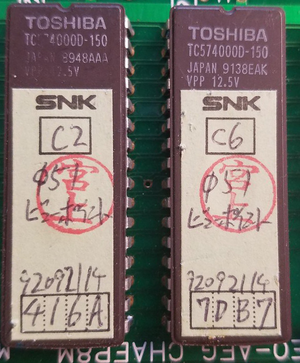
Flux residue
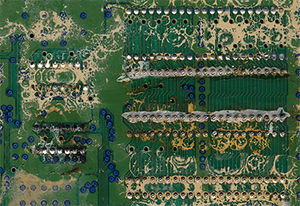
[Flux] used for manual soldering, when not cleaned off, can look like dried barf after a while.
Aside from eventual traces of accidental beer spills, rat piss and dust, original boards should be clean.
